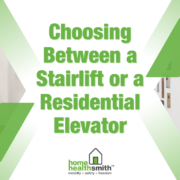Choosing Between a Stairlift Installation or a Residential Elevator
Are aging-in-place home modifications really worth the investment? And how do you decide whether you’d benefit most from a residential elevator or a stairlift installation?
It comes down to a variety of factors including:
- How many levels your home includes
- What your present situation involves
- What’s most important to you
- What your budget allows for
In this article, we’ll take a look at some of the pros and cons of choosing a stairlift vs. a residential elevator, and we’ll talk about how the Home Healthsmith team can help.

What to Consider When Choosing Between a Stairlift Installation or Residential Elevator
Mobility Requirements
A good first step is to start by assessing the mobility needs of the individual or individuals concerned. If the senior or other adult with mobility issues has difficulty climbing stairs but is able to manage navigating short distances independently, then a stairlift could be a good solution.
On the other hand, if they require assistance for vertical movement between multiple floors, then a residential elevator could be a more suitable option.
Space Availability
Survey the available space in your home. Stairlifts require the presence of a specific staircase for installation, so if you have limited space or an unconventional staircase layout, a residential elevator could be a better fit.
At the same time, recognize that elevators typically require a shaft or designated area to be available for proper installation, and this could actually call for more space than what might be required for a comparable stairlift. It is also important to consider space for a machine room/controller closet. This space is anywhere from 2’ x 4’ or 3’ x 4’ based on the type of residential elevator that you choose.
Home Layout and Design
Think about how the installation of a stairlift or elevator will integrate with the layout and design aesthetic of your home interior. Stairlifts are often more discreet and can be designed to blend into the existing staircase, while the installation of an elevator may require more extensive modifications to your home’s structure and interior design.
Cost Considerations
Compare the initial cost and long-term expenses associated with each option.
- Stairlifts are generally more cost-effective upfront, especially for straight staircases, but will likely require some ongoing maintenance costs.
- Residential elevators typically carry a higher initial cost, but can also add value to your home and call for less required maintenance over time.
Accessibility for Others
Evaluate whether other individuals in your household or visitors will benefit more by the installation of a stairlift, or an elevator. If several people with mobility issues reside in the home, or if you frequently host guests with mobility challenges, a residential elevator could offer greater accessibility and more convenience for everyone.
Safety and Convenience
Consider the safety features and convenience offered by each option. Stairlifts typically include safety harnesses, sensors, and other features to ensure safe operation. Residential elevators also offer their own set of safety features, like emergency stop buttons and backup power systems. It really comes down to which option will provide the most peace of mind for both users and caregivers alike.

Future Needs and Resale Value
You should also weigh your future needs, along with how installing a stairlift or an elevator might impact your home’s resale value. If aging-in-place will remain a priority and you anticipate needing mobility assistance for the foreseeable future, then investing in a residential elevator is certainly a long-term solution worth considering. The presence of an elevator can also enhance the value and marketability of your home.
Depending on the layout of your home and what your future needs might entail, there are also several powered lift options to help you navigate home stairways, including vertical platform lifts and stairlifts. These lifts are much less expensive than putting in an elevator, but they are still home improvements that could also serve to give your home resale value a boost.
We’ll Help You Make the Best Decision Between Choosing a Stairlift Installation or a Residential Elevator
At Home Healthsmith, we believe seniors should be able to age safely in the comfort of their own homes, and are committed to offering the best mobility and accessibility solutions.
Not sure where to go from here? If you’re located in Massachusetts, Rhode Island, or Connecticut, one of our trained experts would be glad to come out and conduct a SafeHome Audit. We’ll go room-to-room to identify any safety or accessibility opportunities, and we’ll sit down to discuss your best options and also provide you with a free estimate for any suggested upgrades.
Got questions? Ready to take the next step? We provide the best mobility and accessibility products – including residential elevators, vertical platform lifts, and stairlifts – and we also install everything we sell. Our professional installation process is designed to make everything as smooth and painless as possible for you. We’ll even come back for a return visit to make sure everything is running smoothly!
Get in touch to schedule your free consultation today!




